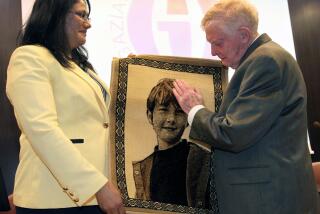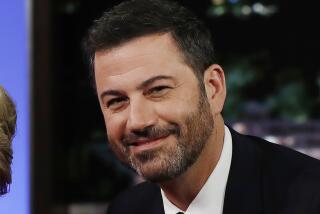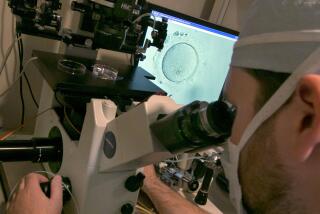Science / Medicine : A Weekly Roundup of News, Features and Commentary : Mending a Baby’s Broken Heart
- Share via
LOMA LINDA, Calif. — Michael and Maria Pritchard were overjoyed when their 4-month-old baby was released from Loma Linda University Medical Center a month after Dr. Leonard L. Bailey and his surgical team replaced her deformed heart with a walnut-sized donor organ on April 28, 1986.
The experimental infant-to-infant heart transplant operation, which offered the only hope their daughter, Rachel, had of surviving a birth defect called hypoplastic right heart syndrome, appeared to have worked.
But two weeks later, Rachel suddenly stopped eating, became irritable and developed a fever and an accelerated heartbeat--signs that her 11-pound body was trying to reject the foreign organ.
It was a “smoldering, sneaky rejection they couldn’t quite stop,” said Maria Pritchard, 32, rocking her now 22-month-old baby in her arms at the small gift shop she owns in San Bernardino.
To counteract the rejection, doctors administered heavy doses of steroids; the procedure stopped the rejection, but the temporary side effects of the steroids horrified Rachel’s parents.
“Her face was covered with hair, she was bloated and her eyebrows met,” Pritchard recalled with a shudder. “She looked like the Michelin Tire Man.” The transformation subsided when the steroid treatment ended and Rachel has not had a rejection episode since.
“Even though she looked so bad, we were overjoyed that she was still with us,” Pritchard said. “After all, she was doomed before the transplant.”
Still, Rachel’s extensive time in the hospital and extraordinarily guarded care at home after surgery have combined to delay her physical and mental development, Pritchard said.
“Her speech is a little rough and her walking is not up to par yet--but she is catching up real fast,” Pritchard said. “Doctors say there has been no brain damage.”
The Pritchards’ experience drives home the fact that as traumatic and difficult as it may be for a child and family to survive an infant heart transplant, the surgery is in some ways only the beginning of the heartbreak and hope, fear and joy.
“You want to know what hell is? Step into my shoes,” said Greig Diggens, 27, of Calgary, Alberta, Canada, the father of Baby Jessica, whose severely malformed heart was replaced with a healthy new one at Loma Linda on Feb. 7, when she was 2 months old. “It is like being trapped and under pressure nobody else could understand.”
Jessica has made it through five rejection episodes--more than any other of Bailey’s eight surviving infant heart transplant recipients at Loma Linda. Today, she is an energetic little blonde with big blue eyes and an endless curiosity about the family’s goldfish bowl and the many stuffed animals and toys that crowd their living room.
Like virtually every other parent of a heart transplant recipient--all but two of whom were recently interviewed by The Times--the parents of Jessica and Rachel are grateful for the surgery and for the life it has given their child. Without the transplant the babies would have lived only a few months at best.
But they also have found that life with a new heart can strain not just the tiny patients, but their families as well.
They can be uprooted from their home, jobs and sometimes even their country.
The families move to Loma Linda to be near the medical center for treatment for as long as a year after surgery. In most cases, the hospital pays the $87,000 cost of the surgery--which is still regarded as experimental in nature--and the cost of housing; some insurance companies are beginning to include infant heart transplants in their coverage, and patients from Canada are eligible for that country’s goverment-run health insurance.
Rejection episodes are virtually certain--only one of the eight newborns who have undergone successful heart transplant surgery here has not had at least one rejection. Rejection episodes can range in severity from mild to deadly and raise the possibility of the need for another transplant operation, hospital officials said. However, there have been no infant deaths at Loma Linda attributed to a rejection episode, officials said.
To combat rejection, the patients are given daily doses of anti-rejection drugs, one of which--cyclosporino--has been known to cause kidney and liver problems and tumors. Those drugs also can reduce the baby’s resistance to disease, prompting fears that even the smallest cough or sniffle could lead to a life-threatening illness.
As a result, parents have to wear sanitary masks whenever they tend their child, and the infants are sequestered from brothers and sisters in the first month after surgery.
Doctors at Loma Linda believe most of these restrictions can be eased a year after surgery. But even then, the long-term future remains uncertain. Although doctors are gradually reducing the dosage of anti-rejection drugs, these babies may have to remain on at least limited doses for the rest of their lives.
The babies remain the object of study by scientists around the world. Bailey, the pediatric heart surgeon who first gained attention by implanting the heart of a baboon into the infant Baby Fae, who died after 20 days, and other Loma Linda officials
are confident that the children--once they’re past the first year after surgery--can expect to lead relatively uneventful childhoods and can look forward to normal life spans.
“This is a very reasonable, rational form of therapy for children of this age,” Bailey said in an interview. “These kids are going to lead normal lives.”
Experts outside Loma Linda, however, are more cautious in their assessment.
“Every one of these kids is an historical landmark and we learn from them every day,” said Dr. Jack Copeland, chief heart transplant surgeon at the University of Arizona, Tucson, and a sometime critic of Bailey.
“But so far, the results of transplantation at best must be summarized as providing temporary survival. We have never been able to guarantee a normal life. That is an unrealistic appraisal of transplantation at this time.”
Loma Linda officials note that a handful of other surgeons around the nation have followed Bailey in performing transplants on newborn infants, although the success rate at other hospitals is not as high as at Loma Linda.
At least eight other medical research institutions and hospitals have conducted infant heart transplant operations since 1985, Loma Linda officials said. Only six of the 10 recipients have survived.
Dr. Sandra Nehlsen-Cannarella, director of Loma Linda’s immunology center, said all eight Loma Linda patients are progressing well.
Nehlsen-Cannarella and other hospital officials said that the babies’ hearts are growing in concert with other organs, that there has been no evidence of toxicity from anti-rejection drugs (doses of which have been reduced to barely detectable amounts for survivors a year old or more), and that their growth curves are similar to those of children who have been sick in the first few months of life--but who demonstrate the ability to catch up.
Bailey is now so confident of the procedure that he is publicly pressing for it to be taken out of the category of experimental surgery, which could lead to wider insurance coverage of the operations. In recent public statements, Bailey has even said that newborns seem better able to survive heart transplant surgery than older babies.
Some other pediatric heart surgeons, however, contend that Bailey’s optimism is premature.
“The concern . . . is that if we do infant heart transplants and then find that the majority (of patients) are dead within a few years . . . then one would have expended an enormous amount of financial and medical resources, and put the family through a difficult course of getting to know and love a child, then have them die,” said Dr. Hillel Laks, chief of the division of cardiothoracic surgery at UCLA.
“One has to put an enormous amount of importance on the mere prolongation of life in order to justify such a procedure.”
Laks and others want to see more infant heart transplant operations conducted at Loma Linda and elsewhere each year, and longer life spans among survivors before they agree that the procedure is anything other than experimental.
Loma Linda officials reply that at this point there is nothing that suggests that these children won’t continue to do well and progress. But even they concede that not all the questions have been, or even can be, answered at this point. For instance, transplant recipients can be expected to face additional hurdles 10 years or so from now.
“At puberty . . . sex hormones could change the immune response,” Nehlsen-Cannarella said. “Since it (infant heart transplantation) had never been done before, we are working in a black box.”
Hospital officials prepare the families of infant transplant recipients with counseling on how to detect such things as lack of appetite and irritability, which can signal a rejection episode. They also provide a list of do’s and don’ts that include keeping the babies away as much as possible from other children who could infect them with an illness, however minor, during the first year after surgery.
Interviews with all but one of the families of the patients found all satisfied with the condition and progress of their children.
The oldest living transplant recipient is Nicholas Anguiano, 2, who was known as Baby Moses when he received his heart transplant operation Nov. 30, 1985. Like most of the transplant recipients, Nicholas suffered from hypoplastic left heart syndrome, a condition that makes it impossible for the heart to adequately pump blood.
On a recent day, he played energetically in the family’s Etiwanda home while his mother, Maria, 23, told a reporter how she watched while her son weathered three rejection episodes and came down with illnesses ranging from common colds to tonsillitis, any one of which could have triggered potentially fatal complications.
Convinced that the worst is over, “I’m already planning for his college and thinking about being a grandmother,” said Maria Anguiano.
Meanwhile, blowing kisses at his mother one moment, screaming “Aaargh!” before leaping off the living room coffee table the next, Nicholas seemed as normal as any other child his age--and anything but fragile.
“At night, when he is sleeping, I watch his little chest rise and fall,” his mother added, fighting back tears, “and I think, God, this is a miracle, and since the miracle is working, I know he will go on living.”
INFANT TRANSPLANT RECIPIENTS AT LOMA LINDA
DATE OF AGE AT CURRENT TRANSPLANT NAME TRANSPLANT STATUS Nov. 20, 1985 Nicholas Anguiano 4 days Living Jan. 23, 1986 Baby Eve 17 days Living April 29, 1986 Rachel Pritchard 3 months Living June 10, 1986 Jesse Sepulveda 16 days Living Sept. 27, 1986 Trevor Reed 24 days Died Oct. 9, 1986 Dec. 1, 1986 Baby Kari 2 months Died Dec. 6, 1986 Feb. 7, 1987 Jessica Diggens 2 months Living Aug. 8, 1987 Baby Victoria 7 days Died Oct. 20, 1987 Oct. 16, 1987 Paul Holc 3 hrs. Living Oct. 26, 1987 Mitchell Boyd 11 days Living Nov.20,1987 Genevieve Brisson 12 weeks Living







